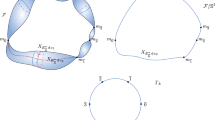Abstract
In this paper we give geometric conditions so that the integral mapping of a Liouville integrable Hamiltonian system with a focus-focus equilibrium point has scattering monodromy. Using a complex version of the Morse lemma, we show that scattering monodromy is the same as the scattering monodromy of the standard focus-focus system.
Similar content being viewed by others
References
Bates, L., Cushman, R.: Scattering monodromy and the \(A1\) singularity. Cent. Eur. J. Math. 5, 429–451 (2007)
Cushman, R.H., Bates, L.M.: Global aspects of classical integrable systems, 2nd edn. Birkhäuser, Basel (2015)
Dullin, H.R., Waalkens, H.: Nonuniqueness of the phase shift in central scattering due to monodromy. Phys. Rev. Lett. 101, 070405 (2008)
Efstathiou, K., Giacobbe, A., Mardes̆ić, P.: Rotation forms and local monodromy. J. Math. Phys 58, 022902 (2017)
Martynchuk, N., Broer, H.W., Efstathiou, K.: Hamiltonian monodromy and Morse theory. Comm. Math. Phys. 375, 1373–1392 (2020)
Vu Ngoc, S., Wacheux, C.: Smooth normal forms for integrable Hamiltonian systems near a focus-focus singularity. Acta. Math. Vietnam 38, 107–122 (2013)
Acknowledgements
The author would like to thank the referees for their careful reading of the manuscript and their comments which pointed out errors in the text.
Funding
The author received no funding for this research.
Author information
Authors and Affiliations
Corresponding author
Ethics declarations
Human and animal rights
This research involved no animals or humans and neither generated nor used any computer programs or data.
Additional information
Publisher's Note
Springer Nature remains neutral with regard to jurisdictional claims in published maps and institutional affiliations.
Appendix
Appendix
In this appendix we prove a complex version of the Morse lemma. Our proof was inspired by the proof of the focus-focus Morse lemma in [6].
Lemma A1
(Morse lemma). Let
where Q is a nondegenerate homogeneous quadratic polynomial and R is a smooth function, which is flat to second order at the origin (0, 0). Then there is an open neighborhood U of (0, 0) in \({\mathbb {C}}^2\) and a diffeomorphism \(\Phi \) of U into itself with \(\Phi (0,0) = (0,0)\) such that \({\Phi }^{*}{{\mathcal {H}}}_1 = Q\) on U. Moreover, \(\Phi \) is isotopic to \({\textrm{id}}_U\).
Proof
By a complex linear change of coordinates we may assume that \(Q(z) = z_1z_2\). We want to find a time dependent vector field \(X = X_t + \frac{\partial }{\partial t}\) on \((0,2) \times {\mathbb {C}}^2\) whose flow \({\varphi }^X_t\) satisfies
Differentiating (28) gives \(0 = ({\varphi }^X_t)^{*}\big ( \frac{\partial \widehat{{\mathcal {H}}} }{\partial t} + L_{X_t}{{\mathcal {H}}}_t \big )\). Since \(\frac{\partial {\mathcal {H}}}{\partial t} = R\), we need to find a vector field \(X_t\) on \({\mathbb {C}}^2\) such that
Now \(\mathop {\! \,\textrm{d} \!}\nolimits H_t(z) = \big ( z_2 + t \frac{\partial R}{\partial z_1}(z) \big ) \mathop {\! \,\textrm{d} \!}\nolimits z_1 + \big ( z_1 + t \frac{\partial R}{\partial z_2}(z) \big ) \mathop {\! \,\textrm{d} \!}\nolimits z_2\). For some smooth functions A and B on \((0,2) \times {\mathbb {C}}^2\)
Since \(R(0) =0\), by the integral form of Taylor’s theorem \(R(z) = G_1(z) z_1 + G_2(z) z_2\), where \(G_j\) are smooth functions with \(G_j(0) = \frac{\partial R}{\partial z_j}(0)\) for \(j=1,2\). Since R is flat to second order at 0, we get \(G_j(0) =0\). Thus (29) can be written as
Again by Taylor’s theorem, \(\frac{\partial R}{\partial z_j}(z) = F_j(z) z_1 + E_j(z) z_2\) for \(j =1,2\), where \(F_j(0) = \frac{{\partial }^2R}{\partial z_1 \, \partial z_j}(0)\) and \(E_j(0) = \frac{{\partial }^2R}{\partial z_2 \, \partial z_j}(0)\). Since R is flat to second order at 0, it follows that \(F_j(0) =0\) and \(E_j(0) =0\). Thus equation (31) becomes
Equating the coefficients of \(z_1\) and \(z_2\) in the equation above, we get
So
Let U be an open neighborhood of \(0 \in {\mathbb {C}}^2\) such that for \(i=1,2\)
Then
Thus the matrix \({\mathcal {A}}(t,z)\) is invertible for all \(z \in U\) and all \(t \in [0,2]\). With \(\begin{pmatrix} A(t,z) \\ B(t,z) \end{pmatrix}\)\(= -{{\mathcal {A}}(t,z)}^{-1}\) \(\begin{pmatrix} G_1(z) \\ G_2(z) \end{pmatrix}\) we have determined the vector field \(X_t\) (30) on \((0,2) \times {\mathbb {C}}^2\) which solves equation (29).
Because \(X_t(0,0) = (0,0)\) we can shrink U if necessary so that the flow \({\varphi }^X_t\) of the vector field X sends \([0,1] \times U\) to U. Set \(\Phi = {\varphi }^X_1\). Then \({\Phi }^{*}{{\mathcal {H}}}_1 =({\varphi }^X_1)^{*}{{\mathcal {H}}}_t = Q\) on U. The diffeomorphism \(\Phi \) is isotopic to \({\textrm{id}}_U\), since it is the time 1 map of a flow. \(\square \)
Rights and permissions
Springer Nature or its licensor (e.g. a society or other partner) holds exclusive rights to this article under a publishing agreement with the author(s) or other rightsholder(s); author self-archiving of the accepted manuscript version of this article is solely governed by the terms of such publishing agreement and applicable law.
About this article
Cite this article
Cushman, R. Geometric Scattering Monodromy. Qual. Theory Dyn. Syst. 22, 108 (2023). https://doi.org/10.1007/s12346-023-00804-0
Received:
Accepted:
Published:
DOI: https://doi.org/10.1007/s12346-023-00804-0



